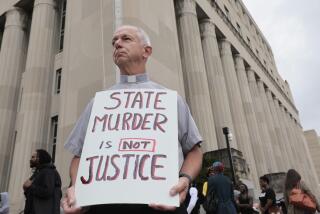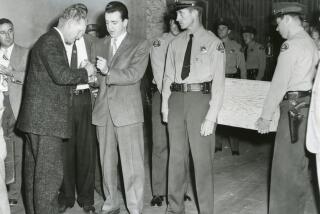To kill, humanely
- Share via
FOR THE LAST WEEK, U.S. District Judge Jeremy Fogel has been considering the case of Michael Morales, who was sentenced to death for the 1981 murder of Terri Winchell in Lodi, Calif. The question facing the judge is whether lethal injection -- California’s preferred method of execution -- violates the U.S. Constitution’s ban on “cruel and unusual” punishment.
But what exactly is cruel? And what’s unusual? Only a few years ago, lethal injection was considered a fast, modern and relatively humane way for the state to put prisoners to death, especially compared to such earlier techniques as hanging, the guillotine and the electric chair. More recently, though, the process has been called into question, with suggestions that it is too uncertain, too prolonged, too painful. One veterinarian recently said the state’s lethal injection procedure caused so much pain and suffering that he wouldn’t even use it on animals.
So how exactly is Fogel to determine whether the process violates the 8th Amendment? What can he turn to in the history of this 300-year-old legal concept to help him make what otherwise seems like an awfully subjective decision?
The phrase “cruel and unusual” first appeared in the English Bill of Rights in 1689, drafted by Parliament at the accession of William and Mary. It seems to have been directed at punishments unauthorized by statute, beyond the jurisdiction of the sentencing court or disproportionate to the offense committed.
After much discussion, the American colonists incorporated the same words into most of the original state constitutions. They became part of the federal Bill of Rights in 1791 as the 8th Amendment: “Excessive bail shall not be required, nor excessive fines imposed, nor cruel and unusual punishments inflicted.”
Based on the debates, it appears the drafters intended that the phrase apply to torture and other “barbarous” methods of punishment such as mutilation, burning, decapitation and drawing and quartering. What mattered was unusual cruelty in the method of punishment; they weren’t concerned (and neither is Fogel) with whether the death penalty itself was cruel and unusual.
Since the 18th century, “cruel” and “unusual” have been coupled in our legal language and courts, and their rhetorical ambiguity has been alternately used to protect prisoners and to legitimize violence against them. Only at the start of the 20th century in Weems vs. United States, and then again in 1958 with the opinion of Chief Justice Earl Warren in Trop vs. Dulles, did the Supreme Court turn away from the mere ban on “barbarous” punishments and begin to consider whether punishments were disproportionate to the offense. In Trop, Warren wrote that it was unconstitutionally cruel to punish a wartime deserter by stripping him of his citizenship; in so ruling, Warren emphasized a flexible interpretation of the 8th Amendment that would adapt to enlightened public opinion. The “dignity of man,” he posited, was the linchpin of the 8th Amendment.
The 8th Amendment attracted great attention during Furman vs. Georgia in 1972. This landmark case declared capital punishment to be cruel and unusual -- and therefore unconstitutional. Not only was it “degrading to human dignity,” wrote Justice William J. Brennan Jr., but it had proved to be “irrational and arbitrary.” Justice Potter Stewart said: “These death sentences are cruel and unusual in the same way that being struck by lightning is cruel and unusual.” The court voted 5 to 4 to strike down every capital punishment law in the United States.
Yet it was Chief Justice Warren E. Burger’s dissent that set the tone for more recent interpretation of the clause. Burger acknowledged “the haze that surrounds this constitutional command” but went on to note that “there are no obvious indications that capital punishment offends the conscience of society to such a degree that our traditional deference to the legislative judgment must be abandoned. It is not a punishment, such as burning at the stake, that everyone would ineffably find to be repugnant to all civilized standards.”
Within just two years, 28 state legislatures retooled capital sentencing laws to make them less “capricious.” In 1976, the Supreme Court reinstated capital punishment.
Given all this, how are we to determine what threshold of suffering triggers a violation? Twenty years after Furman, Keith Hudson, an inmate at the state penitentiary in Angola, La., sued three corrections officers for punching him in the eyes, mouth, chest and stomach. The bruises were minor, but there was swelling of Hudson’s face, mouth and lip; the officers also cracked his dental plate and loosened his teeth. Justice Sandra Day O’Connor decided that the use of excessive physical force of this sort could constitute cruel and unusual punishment, even if no “serious injury” resulted.
Justice Clarence Thomas vehemently disagreed, writing in his dissenting opinion that the judgment had wrenched the 8th Amendment “from its historical moorings.” What did the framers mean, Thomas asked, by “barbarous” punishment? They were thinking of the rack, the thumbscrew, drawing and quartering. How then could a mere beating be “sufficiently serious”? Thomas concluded: “A use of force that causes only insignificant harm to a prisoner may be immoral, it may be torturous, it may be criminal, it may even be remediable under other provisions of the federal Constitution, but it is not ‘cruel and unusual punishment.’ ”
WHERE THE death penalty is concerned, the courts have routinely allowed a certain level of acceptable pain. In 1888, New York legislated a new mode of execution, the electric chair. The condemned man would receive a current of electricity “of sufficient intensity to cause death.” During a sensational case two years later, lawyers appealed William Kemmler’s conviction. If he were killed in this way, they argued, he would suffer “a cruel and unusual, and therefore unconstitutional, punishment” because “a force of electricity to kill any human subject with celerity and certainty, when scientifically applied, cannot be generated.”
The court, however, decided that although electrocution is “certainly unusual,” it is not “cruel.” Then, in 1947, Willie Francis was sentenced to death by a Louisiana court. The attempted electrocution failed because of mechanical difficulties, and Francis petitioned the Supreme Court, arguing that a second attempt to execute him would be unconstitutionally cruel.
The court ruled against him too. Even though he had already suffered the effects of an electrical current, that did not “make his subsequent execution any more cruel in the constitutional sense than any other execution.” What mattered was “cruelty inherent in the method of punishment,” not “the necessary suffering involved in any method employed to extinguish life humanely.” To be “cruel,” punishment must involve “something inhuman and barbarous, something more than the mere extinguishment of life.”
Similarly, the constitutionality of California’s lethal injection procedure, according to Judge Fogel, has nothing to do with whether the inmate has a painless death. “It is inaccurate to say that an execution has to be painless,” he said this week -- only that it cannot “inflict severe degrees of pain.”
Three hundred years later, we’re still debating when pain or suffering becomes severe enough to be called “cruel and unusual.” I fear that the definition will be influenced by the terrible logic, verbal parsing and overspecificity of this administration’s torture memos. In the current climate of hyper-legality, with UC Berkeley law professor John Yoo arguing for a “new legal regime” and a Congress that has just given the go-ahead to reinterpret the Geneva Convention, the meaning of the 8th Amendment could become increasingly unclear, increasingly loose, and the acceptable, allowable level of pain and suffering will grow.
In 1895 in “The History of English Law,” after enumerating such obsolete punishments as burning, drowning, stoning and drawing and quartering, legal historians Frederic William Maitland and Frederick Pollock added, “but the worst cruelties belong to a politer time.”
More to Read
Sign up for Essential California
The most important California stories and recommendations in your inbox every morning.
You may occasionally receive promotional content from the Los Angeles Times.










